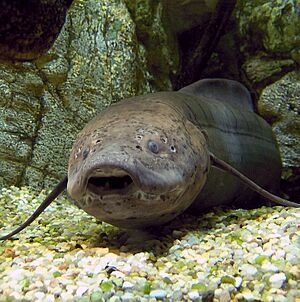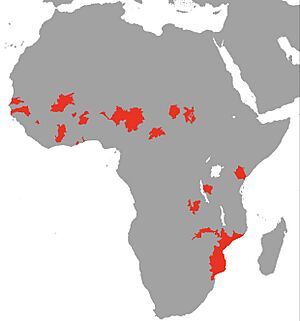West African lungfish facts for kids
Quick facts for kids West African lungfish |
|
|---|---|
 |
|
| Conservation status | |
| Scientific classification | |
| Genus: |
Protopterus
|
| Species: |
annectens
|
| Subspecies | |
|
|
 |
|
| Synonyms | |
|
|
The West African lungfish (Protopterus annectens) is also known as the Tana lungfish or simply African lungfish. This special fish is a type of African lungfish. You can find it in many freshwater places across West and Middle Africa. It also lives in the northern part of Southern Africa.
Contents
What Does It Look Like?
The West African lungfish has a noticeable snout and small eyes. Its body is long and looks like an eel. It can be about 9 to 15 times longer than its head.
This fish has two pairs of long, thin fins. The fins near its head are called pectoral fins. They are about three times the length of its head. The fins near its tail are called pelvic fins. They are about twice the length of its head. It also has three external gills located behind its head.
Its skin has smooth cycloid scales hidden inside. The back of the fish is usually olive or brown. Its belly is lighter in color. It has large dark spots on its body and fins, but not on its belly. West African lungfish can grow up to 1 meter (3.3 feet) long. They can weigh up to 4 kilograms (9 pounds).
Where Does It Live?
The West African lungfish lives all over Africa. There are two main types, called subspecies. One type, P. a. annectens, is mostly found in the Sahel area. It also lives in Guinea and Sierra Leone. The other type, P. a. brieni, is found in the upper Congo River area. It also lives in the Zambezi River in Mozambique.
Its Home and How It Breathes
Like other African lungfish, the West African lungfish needs to breathe air. It lives in freshwater. This fish is also demersal. This means it mostly lives buried in riverbeds.
Rivers and floodplains where it lives often dry up during the dry season. Because of this, the West African lungfish can aestivate. This is like a long sleep or hibernation. It can aestivate for up to a year. However, it usually only aestivates between wet seasons.
What Does It Eat?
The Tana lungfish eats similar things to other lungfish. It likes to eat different kinds of snails and clams, crabs, prawn, and small fish.
This amazing fish can also go without food for a very long time. It can survive for up to three and a half years without eating! During this time, it acts like an aestivating fish. It buries itself in the mud and stays still. It waits until the conditions are better and there is more water and food.
How It Survives Dry Seasons
When the African lungfish aestivates, it digs itself deep into the mud. It goes about 12 to 18 inches (30-45 cm) deep. As the mud dries, the fish produces a lot of mucus. This mucus forms a protective cocoon around its body. This cocoon keeps the fish from directly touching the dry outside world.
Even though it's in a cocoon, the fish still needs to breathe. A small tube made of dried mucus connects to its mouth. This tube allows the fish to get air. During this time, the fish mainly uses protein for energy. It changes waste products into a substance called urea. This urea builds up in its body. The fish only gets rid of it when it returns to the water.
Images for kids


